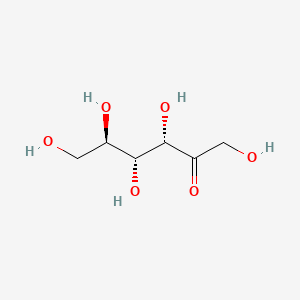Ferroptosis-centered Drug Response Information
General Information of the Drug (ID: ferrodrug0199)
| Name |
D-(-)-Fructose
|
||||
|---|---|---|---|---|---|
| Synonyms |
D-(-)-Fructose; 57-48-7; D(-)-Fructose; (3S,4R,5R)-1,3,4,5,6-pentahydroxyhexan-2-one; D-Levulose; DL-Fructose; 30237-26-4; Methose; arabino-2-Hexulose; keto-D-fructose; 6YSS42VSEV; DTXSID5023081; CHEBI:48095; 02T79V874P; Sugar, fruit; Fructose, D-; Fructose [JAN]; rel-(3S,4R,5R)-1,3,4,5,6-Pentahydroxyhexan-2-one; D-(-)-Fructose, >=99%; Fructose, pure; CAS-57-48-7; D-(-)fructose; (+-)-Fructose; CCRIS 3335; Fructose [USP:JAN]; EINECS 200-333-3; UNII-6YSS42VSEV; MFCD00148910; AI3-23514; D-fructose-ring; UNII-02T79V874P; NCGC00160604-01; Fructose (VAN); Fructose,(S); FUD; Fructon (TN); D(-)-ructose; D-Fructose,(S); pentahydroxyhexan-2-one; FRUCTOSE [INCI]; .ALPHA.-ACROSE; FRUCTOSE [FCC]; FRUCTOSE [MI]; FRUCTOSE, DL-; D-(-)-Fructose, LR; Fructose (JP17/USP); DL-FRUCTOSE [MI]; Topiramate impurity E CRS; FRUCTOSE [WHO-DD]; SCHEMBL3965; D-(-)-Fructose, BioXtra; D-(-)-Fructose, puriss.; D-fructose (open structure); (+/-)-FRUCTOSE; GTPL4654; CHEMBL1232863; FRUCTOSE, (+/-)-; BJHIKXHVCXFQLS-UYFOZJQFSA-N; HY-N7092; Tox21_113557; Tox21_200762; s5176; AKOS015901521; NSC 760385; GLUCOSE IMPURITY D [EP IMPURITY]; NCGC00258316-01; LACTULOSE IMPURITY D [EP IMPURITY]; CS-0008532; D-(-)-Fructose, for microbiology, >=99.0%; D-(-)-Fructose, tested according to Ph.Eur.; D00114; EN300-218371; A870797; D-(-)-Fructose, BioUltra, >=99.0% (HPLC); D-(-)-Fructose, meets USP testing specifications; D-(-)-Fructose, SAJ special grade, >=98.0%; Q122043; TOPIRAMATE IMPURITY, FRUCTOSE- [USP IMPURITY]; (3S,4R,5R)-1,3,4,5,6-; DFA8C62B-E34B-4603-A548-F6A8D25645DD; Fructose, European Pharmacopoeia (EP) Reference Standard; Z1255372738; (3S,4R,5R)-1,3,4,5,6-pentakis(oxidanyl)hexan-2-one; Fructose, United States Pharmacopeia (USP) Reference Standard; D-(-)-Fructose, meets analytical specification of Ph.??Eur., BP; FRUCTOSE (CONSTITUENT OF CRANBERRY LIQUID PREPARATION) [DSC]; Fructose, Pharmaceutical Secondary Standard; Certified Reference Material; D-(-)-Fructose, BioReagent, suitable for cell culture, suitable for insect cell culture; 25702-76-5; D-(-)-Fructose, analytical standard, analytical standard for fructose assay kit, for use with enzymatic assay kit FA20
Click to Show/Hide
|
||||
| Structure |
 |
||||
| Formula |
C6H12O6
|
||||
| IUPAC Name |
(3S,4R,5R)-1,3,4,5,6-pentahydroxyhexan-2-one
|
||||
| Canonical SMILES |
C(C(C(C(C(=O)CO)O)O)O)O
|
||||
| InChI |
InChI=1S/C6H12O6/c7-1-3(9)5(11)6(12)4(10)2-8/h3,5-9,11-12H,1-2H2/t3-,5-,6-/m1/s1
|
||||
| InChIKey |
BJHIKXHVCXFQLS-UYFOZJQFSA-N
|
||||
| PubChem CID | |||||
Full List of Ferroptosis Target Related to This Drug
Stearoyl-CoA desaturase (SCD)
| In total 2 item(s) under this Target | |||||
| Experiment 1 Reporting the Ferroptosis-centered Drug Act on This Target | [1] | ||||
| Target for Ferroptosis | Suppressor | ||||
| Responsed Disease | Nonalcoholic fatty liver disease | ICD-11: DB92 | |||
| Responsed Regulator | Sterol regulatory element-binding protein 1 (SREBF1) | Suppressor | |||
| Pathway Response | Fatty acid metabolism | hsa01212 | |||
| Ferroptosis | hsa04216 | ||||
| Glutathione metabolism | hsa00480 | ||||
| Cell Process | Cell ferroptosis | ||||
| In Vitro Model | hLCs (Liver cells) | ||||
| In Vivo Model |
Four-week-old male and female C57BL/6N mice were obtained from the Central Lab Animal Inc. (Seoul, South Korea) and housed in 42 x 27 x 15 cm polycarbonate cages (six mice per cage). The animals were assigned into either the control group (n = 12; six mice per sex) or fructose intervention group (n = 12; six mice per sex). After a week of acclimation, the fructose group was subjected to 34% fructose in deionized water (wt:vol) over six weeks to induce NAFLD conditions as previously described.11 To note, compared to conventional sugary beverages (e.g., soft drinks), the supplementation level of fructose is higher (11% vs. 34%) to induce liver damage markers within a reasonable intervention time range (i.e., 6 weeks).
Click to Show/Hide
|
||||
| Response regulation | The protein expressions of SREBP1 and its downstream targets ACC1, FASN and SCD1 were all increased in fructose-treated AML12 hepatocytes, which demonstrates fructose mediated upregulation of SREBP1. MiR-33-5p (miR-33) was identified as the key miRNA responsible for SREBP1 regulation upon fructose intake, which was validated by in vitro transfection assay. Collectively, fructose-induced oxidative damage induces ferroptosis, and miR-33 could be used as a serological biomarker of fructose-induced non-alcoholic fatty liver disease (NAFLD). | ||||
| Experiment 2 Reporting the Ferroptosis-centered Drug Act on This Target | [1] | ||||
| Target for Ferroptosis | Suppressor | ||||
| Responsed Disease | Nonalcoholic fatty liver disease | ICD-11: DB92 | |||
| Responsed Regulator | mmu-miR-33-5p (miRNA) | Driver | |||
| Pathway Response | Fatty acid metabolism | hsa01212 | |||
| Ferroptosis | hsa04216 | ||||
| Glutathione metabolism | hsa00480 | ||||
| Cell Process | Cell ferroptosis | ||||
| In Vitro Model | hLCs (Liver cells) | ||||
| In Vivo Model |
Four-week-old male and female C57BL/6N mice were obtained from the Central Lab Animal Inc. (Seoul, South Korea) and housed in 42 x 27 x 15 cm polycarbonate cages (six mice per cage). The animals were assigned into either the control group (n = 12; six mice per sex) or fructose intervention group (n = 12; six mice per sex). After a week of acclimation, the fructose group was subjected to 34% fructose in deionized water (wt:vol) over six weeks to induce NAFLD conditions as previously described.11 To note, compared to conventional sugary beverages (e.g., soft drinks), the supplementation level of fructose is higher (11% vs. 34%) to induce liver damage markers within a reasonable intervention time range (i.e., 6 weeks).
Click to Show/Hide
|
||||
| Response regulation | The protein expressions of SREBP1 and its downstream targets ACC1, FASN and SCD1 were all increased in fructose-treated AML12 hepatocytes, which demonstrates fructose mediated upregulation of SREBP1. MiR-33-5p (miR-33) was identified as the key miRNA responsible for SREBP1 regulation upon fructose intake, which was validated by in vitro transfection assay. Collectively, fructose-induced oxidative damage induces ferroptosis, and miR-33 could be used as a serological biomarker of fructose-induced non-alcoholic fatty liver disease (NAFLD). | ||||
